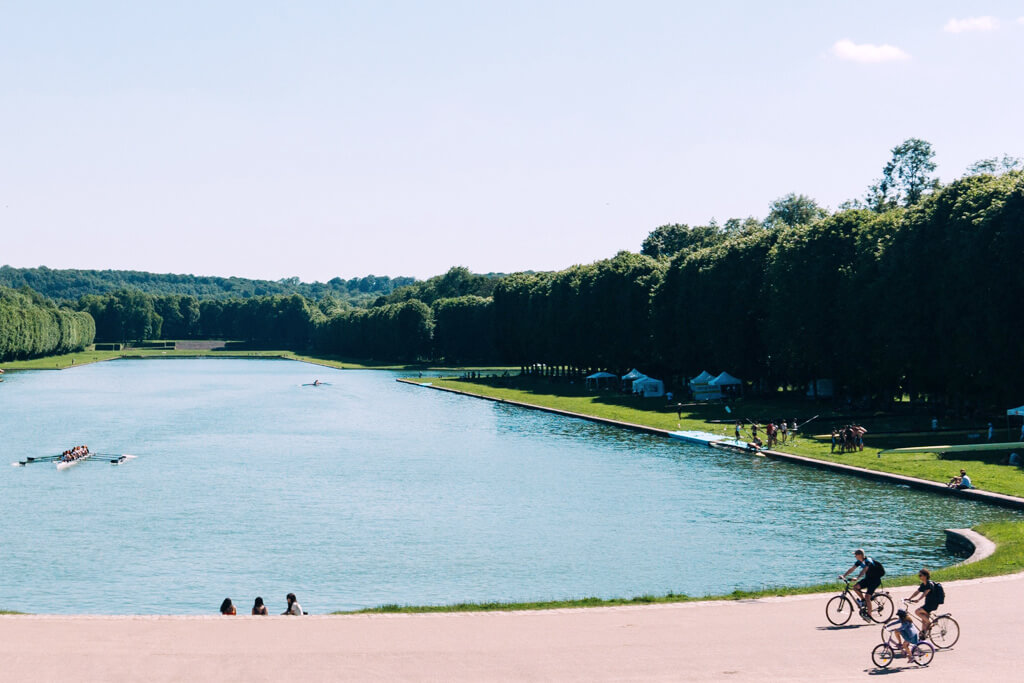This Versailles Fountains guide describes the best fountains at Versailles and how they work. It also gives information on the Versailles Fountains schedule during the Versailles Fountain Show. If you are in a hurry, you can jump directly to the fountains schedule here.
This article was updated in February 2025 with the Versailles Fountains schedule 2025.
The Versailles fountains are one of the highlights of Versailles. They are an integral part of the aesthetics desired by the Sun King and constituted a staging, a show that King Louis XIV used to glorify his reign.
From the early 1660s until his death in 1715, King Louis XIV directed the creation of the Château de Versailles and its surrounding gardens. The best architects, engineers, sculptors, artists, and gardeners were employed – Le Vau, Mansart, Le Brun, Girardon, Le Notre, and more. Their genius was responsible for the individual parts, but the conception of the whole, the overall vision, was throughout that of the King.
Still today, the Fountains of Versailles are the main attraction in Versailles in spring and summer. The fountains’ sculptures spit water that is measured, controlled, and designed to arouse astonishment.
Are you planning your Versailles trip last minute?
Below are some of the best Versailles tours, hotels, and more!
Book your transfer from a Paris airport to Versailles with Welcome Pickups.
Top Experiences and Tours in Versailles:
- Entry Ticket Château de Versailles, Gardens, and Estate of Trianon
- Château de Versailles Priority Entrance Ticket and Guided Tour
- Versailles Bike Tour with Château and Estate of Marie-Antoinette
Save money with the Paris & Versailles Bundle (Château de Versailles + Louvre Museum + Seine River Cruise), 100% digital! Versailles is also included in the Paris Museum Pass.
Top Places to Stay in Versailles:
- Waldorf Astoria Versailles – Trianon Palace (by the Park of the Château de Versailles)
- Hotel Le Versailles (close to the Old Town and the famous Château)
- Hotel des Lys (close to Notre Dame Market and the famous Château)
Don’t leave for Versailles without travel insurance!
» Don’t leave without travel insurance! SafetyWing Essential plan works well for long and short trips (from 5 days up). Can also cover electronics theft through their add-on.
Table of Contents:
- When Do the Fountains at Versailles Run?
- Versailles Fountains Map
- Best Fountains of Versailles
- Versailles Musical Gardens vs. Musical Fountains Shows
- Versailles Fountains Night Show (Les Grandes Eaux Nocturnes)
- Versailles Fountains Schedule
- Versailles Fountains Water Supply
Check out my other Versailles Guides
When Do the Fountains at Versailles Run?
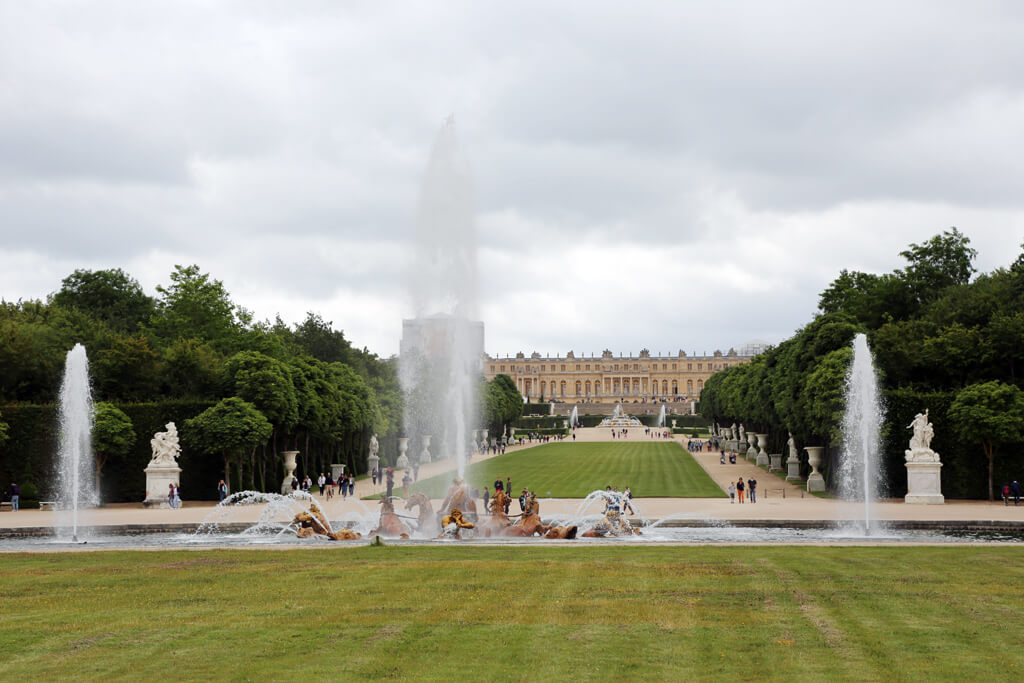
When are the fountains on at Versailles?
The fountains of Versailles run from 1 April to 31 October 2025 (high season in Versailles), but only on specific days and times — more on this in the next chapter. During this period, there’s an entrance fee to access the Petit Parc (where the fountains are located).
From 1 November to 31 March (the low season in Versailles), the fountains don’t run, and some grooves are closed to the public. On the other hand, the Petit Parc (where the fountains are located) is free to visit, and there are fewer visitors.
Versailles Fountains Map
This Versailles Fountains Map shows the best Fountains of Versailles described in the next chapter. All the Fountains of Versailles are located in the Petit Parc (the French-style garden). The Petit Parc is free to visit during the low season, from 1 November to 31 March.
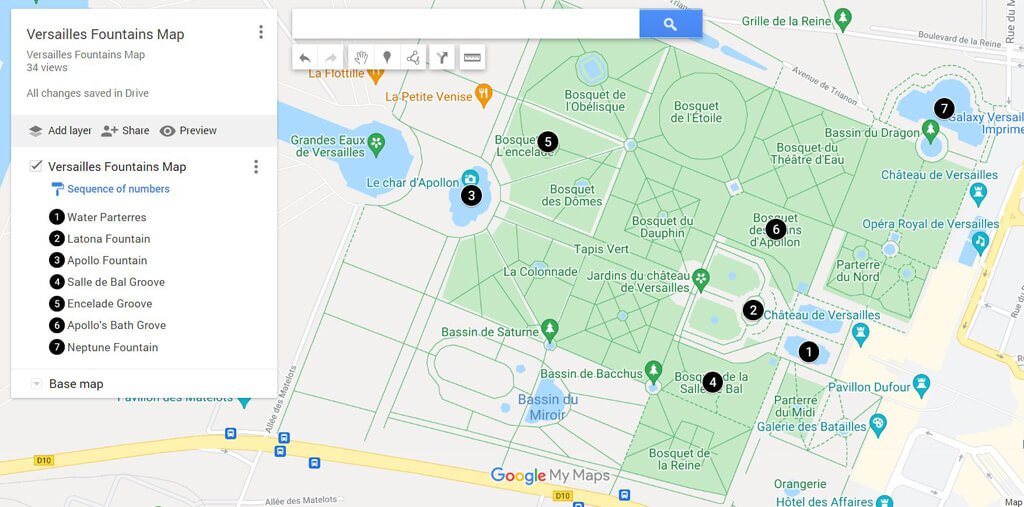
Best Fountains of Versailles
The Fountains of Versailles are designed in different styles and sizes, and they all tell a different story. The construction and management of the Versailles Fountains is fascinating, too. Being Versailles set far from a water source, the water supply to ensure the fountains’ functioning was always a big challenge!
Here’s a selection of the best Fountains at Versailles, both for their beauty and strategic importance in water distribution.
How many fountains are there at Versailles? In Versailles, there are 50 fountains and 620 water jets connected by 35 km of piping.
Water Parterres (Parterres d’Eau)
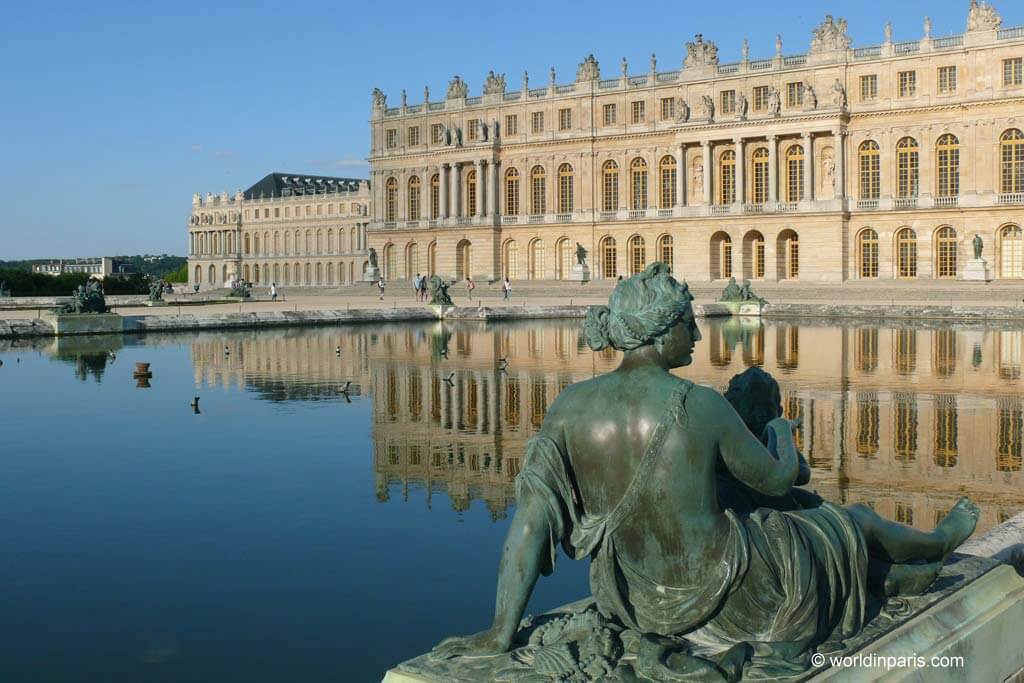
These water parterres at the foot of the Château (Mirror Basin) have two water jets. Because they are visible from the Palace, King Louis XIV wanted to see the water jets working all the time.
The basins are bordered by four groups of two sculptures representing the main French rivers and their tributaries.
Below the terrace, there’s a big water reservoir of 3,400 m3. It was built in 1672 to supply the Palace of Versailles’ fountains. From here, the water is distributed to the Latona Fountain or the Salle de Bal. This underground site is like a small water cathedral!
Latona Fountain
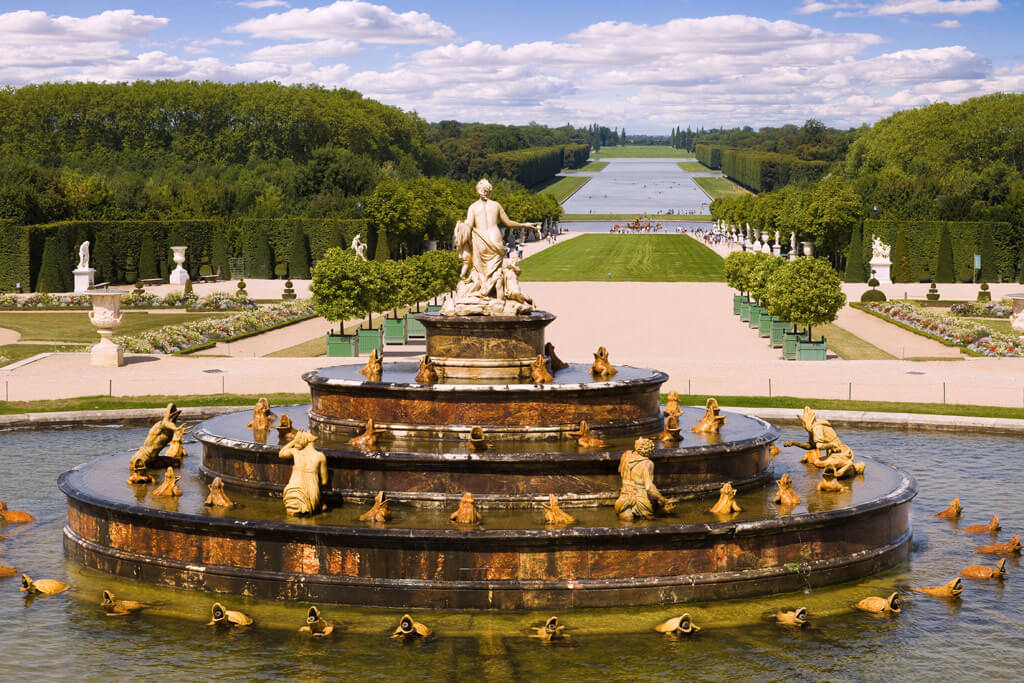
This is one of the most important fountains at Versailles, from an aesthetic and symbolic point of view and a technical point of view.
Latona Fountain is part of the Grande Perspective, together with the Apollo Fountain and the Grand Canal. It illustrates the story of Latona, the mother of Apollo and Diana, who protects her children from the insults of Lycia’s peasants. She pleads with Jupiter to avenge her, and the god turns the inhabitants of Lycia into frogs and lizards. Latona Fountain also has a parterre containing two Lizard Fountains.
Latona Fountain occupies a nodal place in the heart of the Petit Parc, and it has the role of redistributing the waters. Thanks to this fountain, Versailles gets the necessary water to feed most of the fountains.
The water jets on the Water Parterres above converge into the Latona Fountain. This fountain spreads the water, always by gravity, to the water basins in the south, to a part of the Enceladus Fountain, and to Apollon’s Chariot below.
Latona Fountain is a fascinating fountain also below the ground. It has around 70 water jets, each fed by a different pipe, creating a complex network of pipes nicknamed “the spider.” This civil work of engineering is unique in the world, and most of these pipes still date from the reign of King Louis XIV!
Apollo Fountain
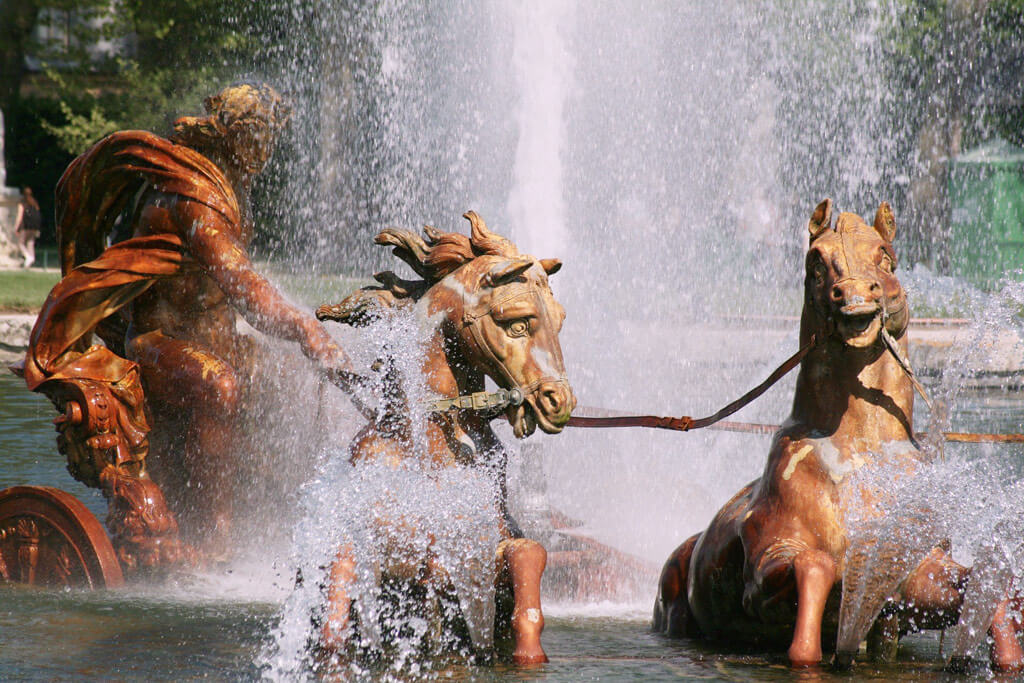
The Apollo Foutain is another of the key elements of the Grande Perspective. It has existed since the time of King Louis XIII, and it was known as the Lake of the Swans. Later, King Louis XIV added the spectacular Apollo riding his chariot.
Apollo is the Sun God, one of the 12 Greek Gods of Mount Olympus, and the symbol of King Louis XIV. The Apollo Fountain features the god bursting forth from the water in anticipation of his daily flight above the earth.
The Apollo Fountain is fed by Latona Fountain by gravity.
La Salle de Bal (The Ballroom)
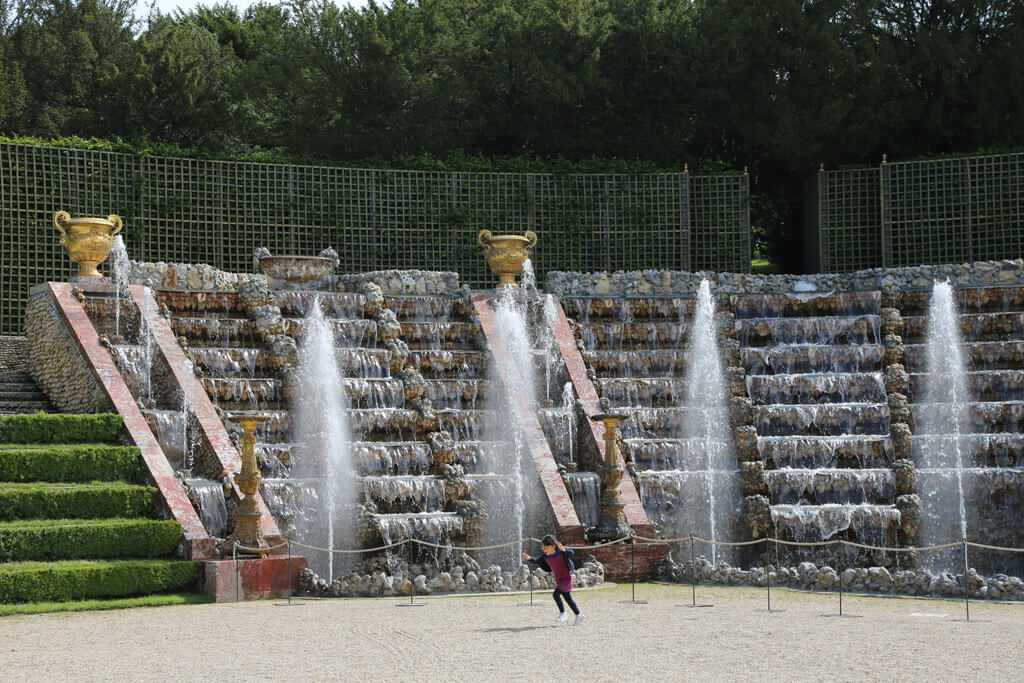
The Salle de Bal is the last groove designed by André Le Notre between 1678 and 1682, and it represents a kind of open-air amphitheater.
Here, Le Notre got the most out of the land’s different elevations by creating a big cascade where the water arrives by gravity from the reservoirs below the Palace’s water beds. In the center of this ballroom, there was a kind of stage or dance floor (today disappeared) while the musicians were found on the top of the amphitheater.
This Salle de Bal was not good for shows (the cascade is very noisy), but the King organized frequent soirées or dinners here. These dinners were delightful in the summer, surrounded by the wall of freshwater.
The Salle de Bal is closed during the winter. It is only accessible during the Versailles Fountain Shows.
Enceladus Fountain
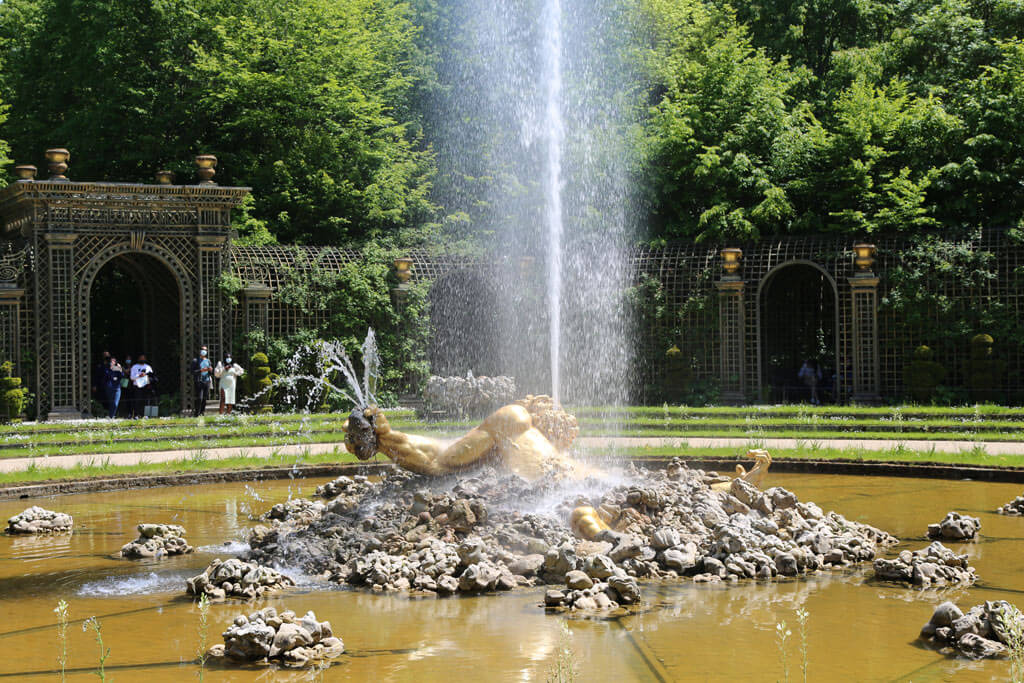
This is one of the most original fountains Versailles has to offer. The Enceladus Fountain dates from 1675, and it represents the giant Enceladus buried under the rocks of Mount Olympus by the gods he and his brothers had wished to dethrone.
In the fountain, the giant is struggling to survive, and his suffering is captured by a powerful water jet that springs from his mouth like a scream.
Enceladus has an impressive water jet of 23 meters, one of the gardens’ highest jets. This fountain is only accessible during the Versailles Fountain Shows, but out of season, you can see the giant from the fence.
Apollo’s Bath
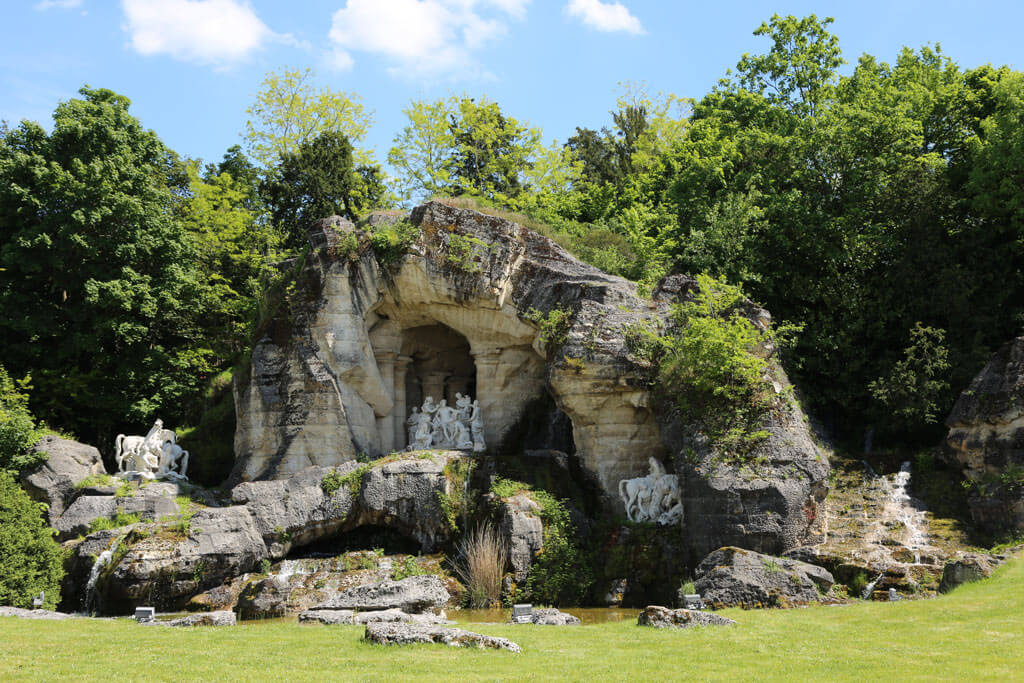
This groove was designed by the painter Hubert Robert during King Louis XVI’s reign between 1778 and 1781. It features three sculpture groups and represents the care provided to Apollo (the Sun God) and his horses after their daytime flight above the Earth.
“When the Sun is tired and has ended his day in the west
He goes down to Tethys place to take his rest
Thus, Louis relaxes in the same way
From a duty that begins each day again.”
The sculptures were recycled from the Tethys Grotto, which was demolished to build the present North Wing of the Palace, and they are considered a masterpiece of French sculpture in the 17th century.
This groove is only accessible during the Versailles Fountain Shows, and there’s no way to see anything of this fountain during the low season.
Neptune Fountain
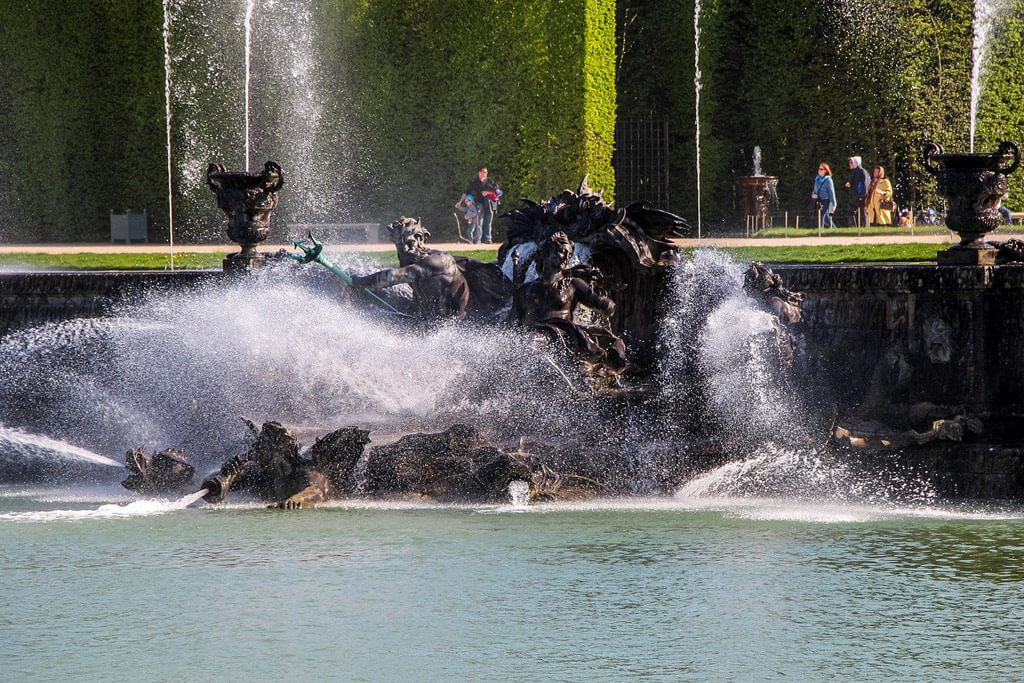
The Neptune Fountain, in the north of the Petit Parc, marks the Gardens’ perspective North-South. This basin was designed under the reign of King Louis XIV but only finished with the last sculptures under King Louis XV.
The central sculpture group represents the God Neptune and Amphitrite, while the other two sculpture groups represent Proteus and Ocean with numerous marine animals.
The Neptune Fountain is greatly admired for the number, size, and variety of water jets falling around the lead sculptures, and the historic jet finale at the end of the afternoon is the highlight of the Versailles Fountain Show.
The Neptune Fountain receives the waters from the other fountains located above. Thanks to its 99 water jets, the basin turns into a water wall, closing the perspective together with the Dragon Fountain just behind it.
Versailles Musical Gardens vs. Musical Fountains Shows
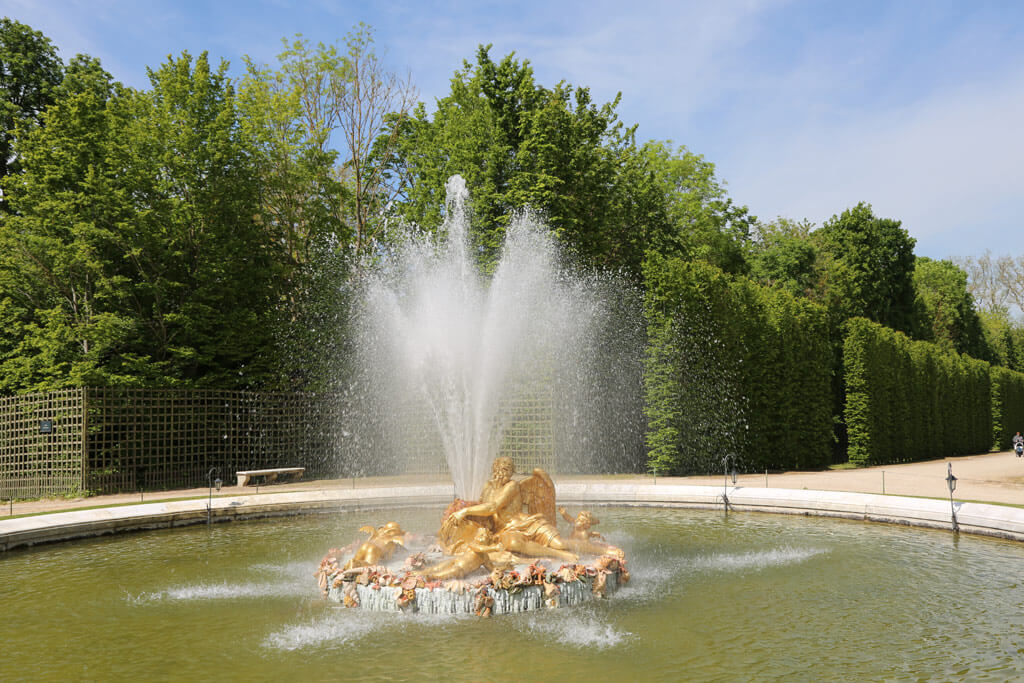
During the high season, the Versailles Gardens host three different shows: the Versailles Musical Gardens, the Versailles Fountain Show, and Les Grandes Eaux Nocturnes (Versailles Fountains Night Show).
The main difference between the two day shows (Versailles Musical Gardens vs. Musical Fountains shows) is that the Versailles Musical Gardens show does not have the fountains running. For this reason, the ticket to the Versailles Musical Fountains show costs a bit more.
You can visit one of the Versailles shows alone, without the Château, or buy a combined ticket to the Château of Versailles and Gardens to save money – Click here to buy your tickets to Château de Versailles and Gardens
Versailles Musical Fountains Show Dates
- Every Saturday and Sunday from 5 April until 26 October 2025
- Every Tuesday from 6 May to 24 June 2025
- Certain holidays: Good Friday on 18 April, Easter Monday on 21 April, Thursday 8 May, Ascension on Thursday 29 May, Pentecost Monday on 9 June, Assumption on Friday 15 August
Versailles Musical Gardens Show Dates
- Every Tuesday, Wednesday, Thursday, and Friday from 1 April to 2 May 2025
- Every Wednesday, Thursday, and Friday from 7 May to 27 June 2025 (except certain holidays, with the Musical Fountain Shows)
- Every Tuesday, Wednesday, Thursday, and Friday from 1 July to 31 October 2025 (except certain holidays, with the Musical Fountain Shows)
Versailles Fountains Night Show (Les Grandes Eaux Nocturnes)
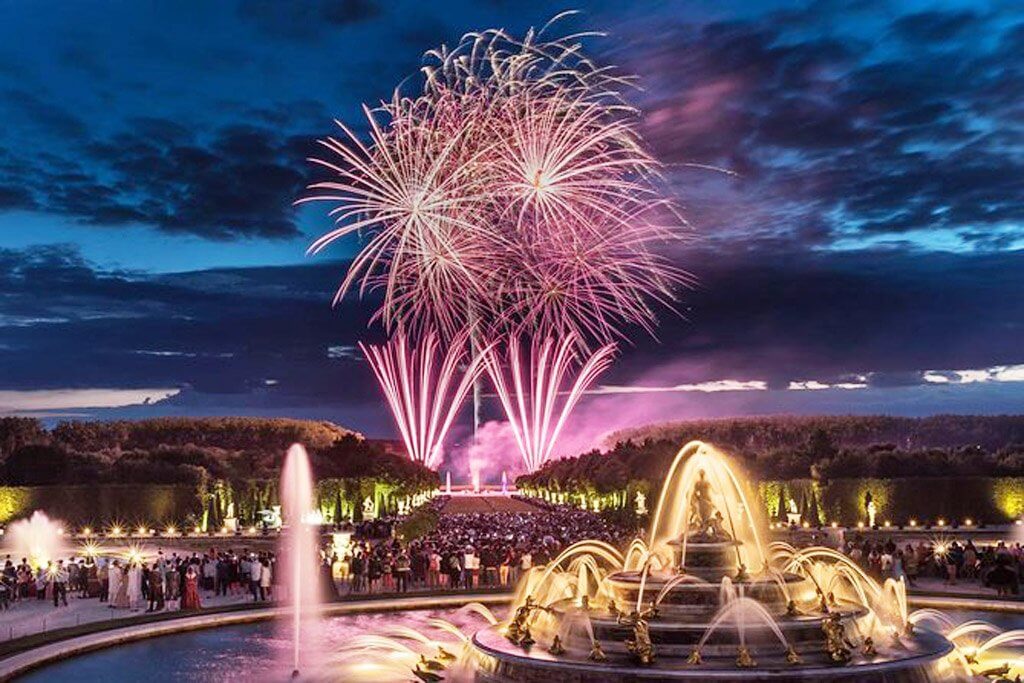
During the Fountains Night Show, the Gardens of Versailles are transformed into a striking visual and musical experience. Stroll the gardens beautifully illuminated, with the fountains and grooves displaying water at the sound of music. The show ends with a ‘grand finale,’ fireworks display in front of the Grand Canal – Click here to buy the tickets to the Fountains Night Show
Dates:
- All the Saturday evenings from 7 June to 20 September 2025, from 8.30 p.m. to 11.05 p.m.
- On special soirées: 14 July (National Day), 15 August (Nocturnes de Feu), Saturday 20 September (Nocturnes Electro).
TIP: Transportation in Versailles after the Fountains Night Show is complicated. The last train to Paris runs until about midnight, a connection which is doable but very tight, especially because everybody waits until the end of the show (Grand Finale) to leave the grounds. Avoid the hassle of running to catch the last (and hyper-crowded) train by booking a private transfer from Versailles to your hotel in Paris with Welcome Pickups.
You can also decide to spend the night in one of the hotels near Château de Versailles and use the second day for exploring the city or a bike ride + picnic in the park.
Versailles Fountains Schedule
When are the fountains on at Versailles? During the Versailles Fountain Shows, it is important to understand that the fountains are not running all day. There’s a Versailles Fountains schedule you should get familiar with, especially if you also want to visit the Château and Trianons.
Before leaving for Versailles, study the Versailles Fountains schedule and the Versailles Fountain Show times, and plan your Versailles itinerary accordingly.
1. Automatic fountains of Versailles running all day:
Neptune’s basin:
- weekends: from 10 a.m. to 5 p.m., then from 5:45 to 6:45 p.m. – 5 minutes every 15 minutes
- Tuesdays and holidays: from 10 a.m. to 6:45 p.m. – 5 minutes every 15 minutes
The Mirror Basin: from 10 a.m. to 7 p.m.* – 7 minutes every 10 minutes
The Water Theater Grove: continuously from 10 a.m. to 7 p.m.*
2. Other Fountains’ Schedule in the morning:
The Great Perspective (the Water Parterre, the Latona Basin, and the Apollo Basin): from 10:30 a.m. to 12 p.m.
Groves and pools on the south side: groves of the Ballroom, the Colonnade, the Girandole, and the Room of the Chestnut Trees, as well as the Bacchus and Saturn pools, are running from 10:30 to 11:30 a.m.
3. Other Fountains’ Schedule in the afternoon:
The Great Perspective (the Latona Basin and the Apollo Basin): from 2 to 2:30 p.m., from 3 to 4:15 p.m., and from 4:45 to 5 p.m.
All groves and ponds in the gardens: from 2:30 to 3:15 p.m. and from 4 to 4:45 p.m.
Water display of Neptune Basin with a historic jet finale at 5:20 p.m.
Versailles Fountains Water Supply
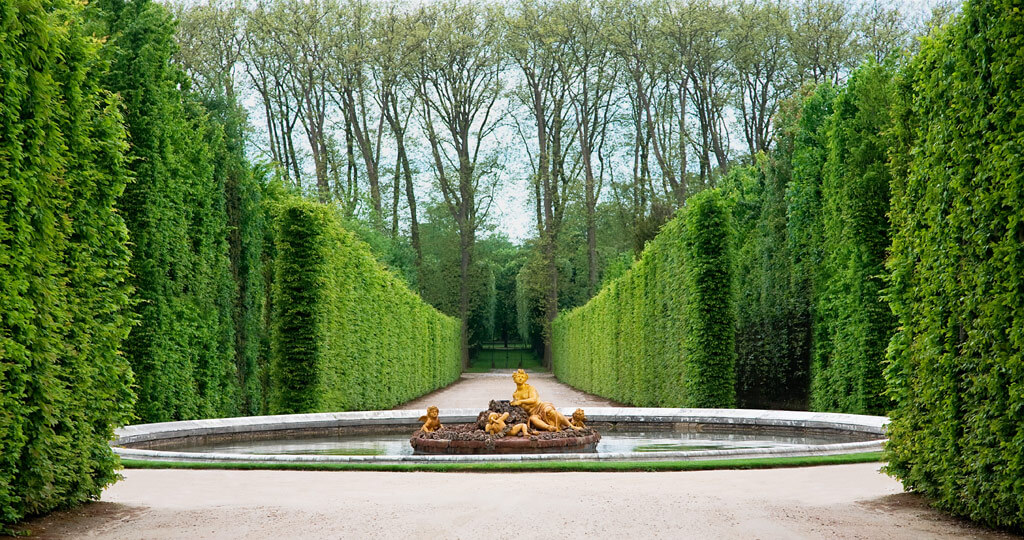
How do the Fountains of Versailles work? The Versailles fountains are an alliance of art and technique that requires a lot of water. When all the fountains were running, in 1715, they consumed the totality of 69,000 muids (one muid is equivalent to about 130 liters) of water in three hours!
The Château’s location, on the top of the hill and far from any water source, was not ideal for such a big project of water basins and fountains. Therefore, water supply was a recurring problem in Versailles.
This technical challenge required the help of hydraulic engineers, architects, and fountain masters who had to think about bringing water to Versailles, redistributing it to the fountains, and creating surprising water effects to arouse visitors’ wonder.
The first solution to solve this water issue was to create an artificial pond near the Château, the Lac de Clagny. From there, water was pumped with the help of water mills, windmills, or pumps moved by horse carousels and then stocked in the reservoirs in the Domain of Versailles. This first hydraulic system made it possible to supply the dozen or so existing fountains, and King Louis XIV inaugurated the first Grandes Eaux de Versailles on 17 August 1666.
But the King wanted to add other fountains and water jets, so more water was necessary. During the following years, the hydraulic engineers brought more water to the Domain of Versailles by constructing other artificial ponds. Bucket windmills, siphons, and aqueducts completed the network to bring the water from the ponds to the reservoirs in the Domain of Versailles.
Over the years, the wooden pipes were replaced by lead pipes and then by cast iron. The hydrant man became an important function in the Palace, the key to the fountains’ good operation, to the point that the King ennobled some of them.

The Machine de Marly – The Eighth World Wonder

The idea of pumping water from the Seine River, the major river closest to Versailles, had existed for several years. However, the distance of 10 km, and especially the drop of 142 meters, required the design of a monumental and expensive machine to pump water and bring it to Versailles’ reservoirs.
Read about the Machine de Marly, which was considered the Eighth World Wonder and was visited by important dignitaries like Queen Victoria of England, the Tsar of Russia, and the US President.
Water Supply in Versailles Today
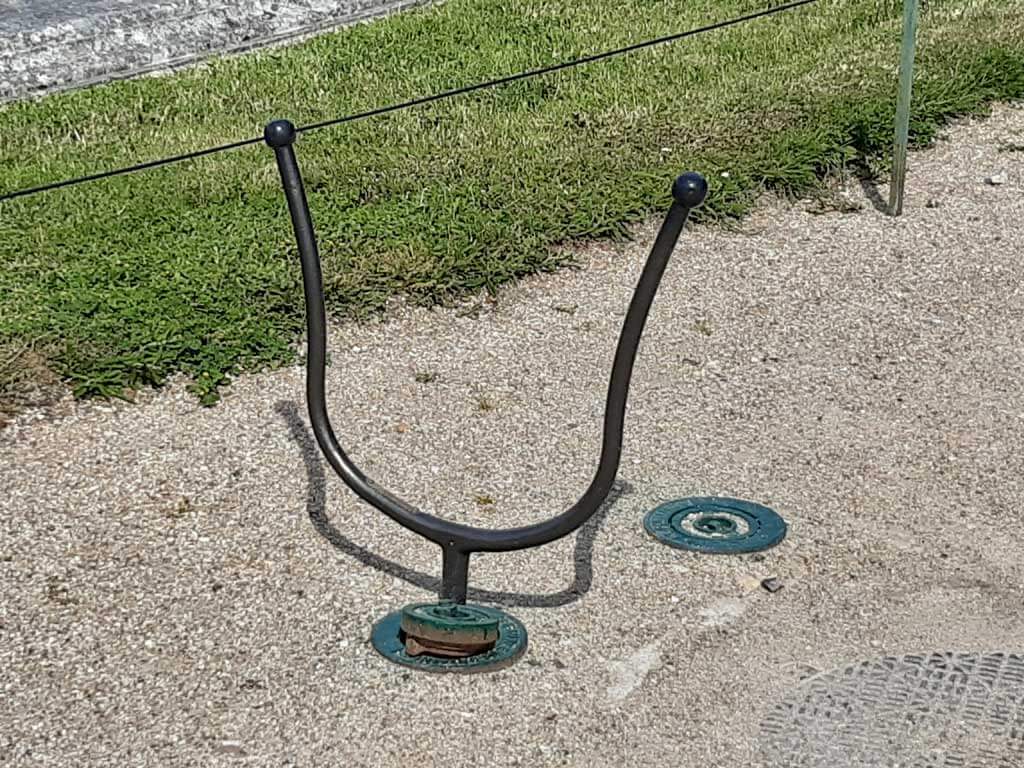
Today, the waters of Versailles Park operate in a closed circuit that consumes 4,500 m3 per hour, with 35 km of the piping system unchanged since the 17th century. A team of 13 hydrant men manages this circuit.
An electric pump pumps water from the Grand Canal and refills the Park’s reservoirs at the foot of the Palace. Rainwater helps complete this system. The different Fountains of Versailles are supplied with water by gravity.
Most of the fountains are still opened manually by the hydrant men. During the Versailles Fountain Show, you will see them wandering around the fountains, and they still use the same keys to open and close the fountains from the times of the Sun King!


